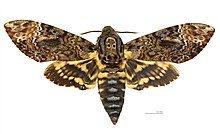Acherontia lachesis: Difference between revisions
No edit summary |
No edit summary |
||
| Line 32: | Line 32: | ||
[[File:Acherontia lachesis 2.jpg|thumb|200px|left|A live Death's head Hawkmoth from Arunachal Pradesh, India]] |
[[File:Acherontia lachesis 2.jpg|thumb|200px|left|A live Death's head Hawkmoth from Arunachal Pradesh, India]] |
||
[[File:HorsfieldMoorCatalogueEastIndiaCompanyLepidopteraPlateIX.jpg|thumb|200px|left| larva (2) and pupa (2a)of ''Acherontia lachesis'']] |
[[File:HorsfieldMoorCatalogueEastIndiaCompanyLepidopteraPlateIX.jpg|thumb|200px|left| larva (2) and pupa (2a)of ''Acherontia lachesis'']] |
||
==Description== |
|||
''A. lachesis'' is larger and much larger than ''[[Acherontia styx]]''. The segmental bands and grey stripe occupying so much of the abdomen that only small patches of yellow are left. Hind wing with a large black patch at the base. The medial and post-medial bands so broad that only narrow bands of the yellow remain. Ventral side of abdomen is banded with black and wings banded with black and with a spot in the cell of each. Larva differs from ''A. styx'' in having blue streaks above the yellow ones; before pupating it turns brown and the oblique streaks disappear.<ref>{{cite web | url=http://dli.serc.iisc.ernet.in/handle/2015/207319 | title=The Fauna Of British India Including Ceylon And Burma Moths Vol-i | publisher=Digital Library of India | date=1892 | accessdate=4 July 2016 | author=Hampson G. F. | pages=558}}</ref> |
|||
==Development== |
==Development== |
||
Revision as of 12:52, 5 July 2016
| Acherontia lachesis | |
|---|---|

| |
| Acherontia lachesis Female Dosal view | |

| |
| Acherontia lachesis Female Ventral view | |
| Scientific classification | |
| Kingdom: | |
| Phylum: | |
| Class: | |
| Order: | |
| Family: | |
| Genus: | |
| Species: | A. lachesis
|
| Binomial name | |
| Acherontia lachesis (Fabricius, 1798)
| |
| Synonyms | |
| |
Acherontia lachesis is a large (up to 13 cm wingspan) Sphingid moth found in India, Sri Lanka and much of the Oriental region, one of the three species of Death's-head Hawkmoth, also known as the Bee Robber. It is nocturnal, and very fond of honey; they can mimic the scent of honey bees so that they can enter a hive unharmed to get honey. Their tongue, which is stout and very strong, enables them to pierce the wax cells and suck the honey out. This species occurs throughout almost the entire Oriental region, from India, Pakistan and Nepal to the Philippines, and from southern Japan and the southern Russian Far East to Indonesia, where it attacks colonies of several different honey bee species. It has recently become established on the Hawaiian Islands.[1]


Description
A. lachesis is larger and much larger than Acherontia styx. The segmental bands and grey stripe occupying so much of the abdomen that only small patches of yellow are left. Hind wing with a large black patch at the base. The medial and post-medial bands so broad that only narrow bands of the yellow remain. Ventral side of abdomen is banded with black and wings banded with black and with a spot in the cell of each. Larva differs from A. styx in having blue streaks above the yellow ones; before pupating it turns brown and the oblique streaks disappear.[1]
Development
Eggs are laid on a variety of hostplants, belonging to the families Solanaceae, Verbenaceae, Fabaceae, Oleaceae, and Bignoniaceae, among others. Mature larvae can attain 125mm long, and occur in green, yellow, and brownish grey color forms (most commonly grey), with oblique body stripes and a prickly tail horn that is curled at the extreme tip. When molested the caterpillar throws the head and anterior segments of the body from side to side, at the same time making a rapidly repeated clicking noise, which appears to be produced by the mandibles. The larva pupates by pushing its head into the earth, burying itself, and making an ovoid chamber about 15 cm below the surface in which it sheds its skin.
Subspecies
- Acherontia lachesis lachesis
- Acherontia lachesis diehli Eitschberger, 2003
- ^ Hampson G. F. (1892). "The Fauna Of British India Including Ceylon And Burma Moths Vol-i". Digital Library of India. p. 558. Retrieved 4 July 2016.
